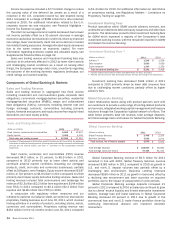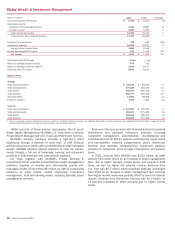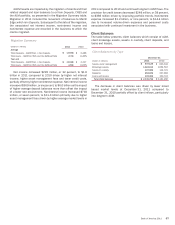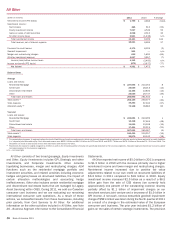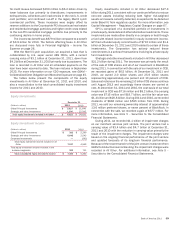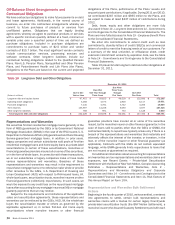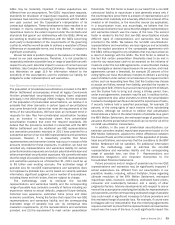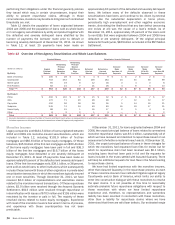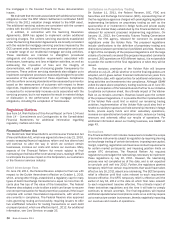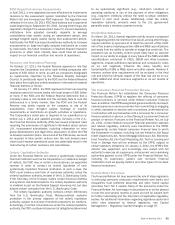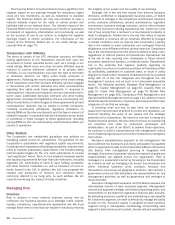Bank of America 2011 Annual Report Download - page 55
Download and view the complete annual report
Please find page 55 of the 2011 Bank of America annual report below. You can navigate through the pages in the report by either clicking on the pages listed below, or by using the keyword search tool below to find specific information within the annual report.Bank of America 2011 53
GSEs may be materially impacted if actual experiences are
different from our assumptions. The GSEs’ repurchase requests,
standards for rescission of repurchase requests, and resolution
processes have become increasingly inconsistent with the GSE’s
own past conduct and the Corporation’s interpretation of its
contractual obligations. These developments have resulted in an
increase in claims outstanding from the GSEs. We intend to
repurchase loans to the extent required under the contracts and
standards that govern our relationships with the GSEs. While we
are seeking to resolve our differences with the GSEs concerning
each party’s interpretation of the requirements of the governing
contracts, whether we will be able to achieve a resolution of these
differences on acceptable terms, and timing thereof, is subject to
significant uncertainty.
We are not able to predict changes in the behavior of the GSEs
based on our past experiences. Therefore, it is not possible to
reasonably estimate a possible loss or range of possible loss with
respect to any such potential impact in excess of current accrued
liabilities. See Complex Accounting Estimates – Representations
and Warranties on page 119 for information related to the
sensitivity of the assumptions used to estimate our liability for
obligations under representations and warranties.
Non-Government-sponsored Enterprises
The population of private-label securitizations included in the BNY
Mellon Settlement encompasses almost all legacy Countrywide
first-lien private-label securitizations including loans originated
principally in the 2004 through 2008 vintages. For the remainder
of the population of private-label securitizations, we believe it is
probable that other claimants in certain types of securitizations
may come forward with claims that meet the requirements of the
terms of the securitizations. We have seen an increased trend in
requests for loan files from private-label securitization trustees
and an increase in repurchase claims from private-label
securitization trustees that meet the required standards. We
believe that the provisions recorded in connection with the BNY
Mellon Settlement and the additional non-GSE representations
and warranties provisions recorded in 2011 have provided for a
substantial portion of our non-GSE representations and warranties
exposure. However, it is reasonably possible that future
representations and warranties losses may occur in excess of the
amounts recorded for these exposures. In addition, we have not
recorded any representations and warranties liability for certain
potential monoline exposures and certain potential whole loan and
other private-label securitization exposures. We currently estimate
that the range of possible loss related to non-GSE representations
and warranties exposure as of December 31, 2011 could be up
to $5 billion over existing accruals. The estimated range of
possible loss for non-GSE representations and warranties does
not represent a probable loss, and is based on currently available
information, significant judgment, and a number of assumptions,
including those set forth below, that are subject to change.
The methodology used to estimate the non-GSE
representations and warranties liability and the corresponding
range of possible loss considers a variety of factors including our
experience related to actual defaults, projected future defaults,
historical loss experience, estimated home prices and other
economic conditions. Among the factors that impact the non-GSE
representations and warranties liability and the corresponding
estimated range of possible loss are: (1) contractual loss
causation requirements, (2) the representations and warranties
provided, and (3) the requirement to meet certain presentation
thresholds. The first factor is based on our belief that a non-GSE
contractual liability to repurchase a loan generally arises only if
the counterparties prove there is a breach of representations and
warranties that materially and adversely affects the interest of the
investor or all investors, or the monoline insurer (as applicable),
in a securitization trust, and accordingly, we believe that the
repurchase claimants must prove that the alleged representations
and warranties breach was the cause of the loss. The second
factor is related to the fact that non-GSE securitizations include
different types of representations and warranties than those
provided to the GSEs. We believe the non-GSE securitizations’
representations and warranties are less rigorous and actionable
than the explicit provisions of the comparable agreements with
the GSEs without regard to any variations that may have arisen as
a result of dealings with the GSEs. The third factor is related to
the fact that certain presentation thresholds need to be met in
order for any repurchase claim to be asserted on the initiative of
investors under the non-GSE agreements. A securitization trustee
may investigate or demand repurchase on its own action, and most
agreements contain a threshold, for example 25 percent of the
voting rights per trust, that allows investors to declare a servicing
event of default under certain circumstances or to request certain
action, such as requesting loan files, that the trustee may choose
to accept and follow, exempt from liability, provided the trustee is
acting in good faith. If there is an uncured servicing event of default,
and the trustee fails to bring suit during a 60-day period, then,
under most agreements, investors may file suit. In addition to this,
most agreements also allow investors to direct the securitization
trustee to investigate loan files or demand the repurchase of loans,
if security holders hold a specified percentage, for example 25
percent, of the voting rights of each tranche of the outstanding
securities. Although we continue to believe that presentation
thresholds are a factor in the determination of probable loss, given
the BNY Mellon Settlement, the estimated range of possible loss
assumes that the presentation threshold can be met for all of the
non-GSE securitization transactions.
In addition, in the case of private-label securitizations, our
estimate considers implied repurchase experience based on the
BNY Mellon Settlement, adjusted to reflect differences between
the Covered Trusts and the remainder of the population of private-
label securitizations, and assumes that the conditions to the BNY
Mellon Settlement will be satisfied. For additional information
about the methodology used to estimate the non-GSE
representations and warranties liability and the corresponding
range of possible loss, see Note 9 – Representations and
Warranties Obligations and Corporate Guarantees to the
Consolidated Financial Statements.
Future provisions and/or ranges of possible loss for non-GSE
representations and warranties may be significantly impacted if
actual experiences are different from our assumptions in our
predictive models, including, without limitation, those regarding
ultimate resolution of the BNY Mellon Settlement, estimated
repurchase rates, economic conditions, estimated home prices,
consumer and counterparty behavior, and a variety of other
judgmental factors. Adverse developments with respect to one or
more of the assumptions underlying the liability for representations
and warranties and the corresponding estimated range of possible
loss could result in significant increases to future provisions and
this estimated range of possible loss. For example, if courts were
to disagree with our interpretation that the underlying agreements
require a claimant to prove that the representations and warranties
breach was the cause of the loss, it could significantly impact this



